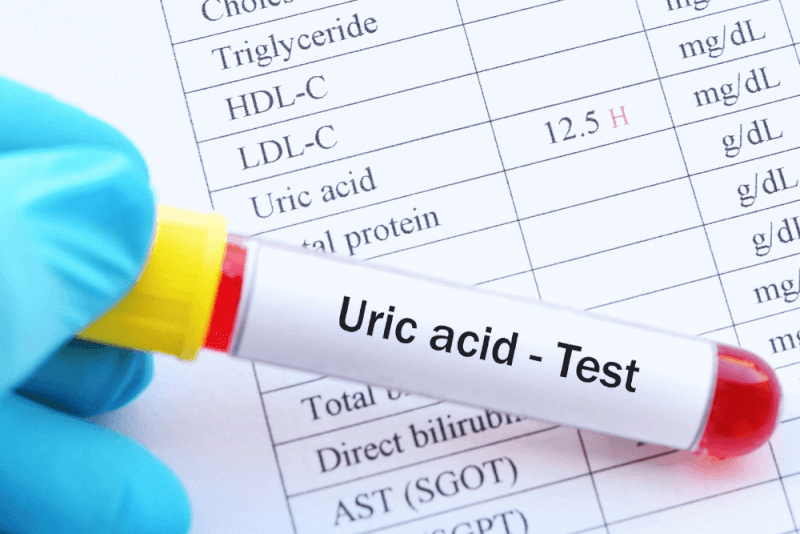30-Second Summary
- A significant portion of uric acid dissolves in the blood, passes through the kidneys, and is excreted in urine.
- Uric acid tends to cluster in sharp crystals. These crystals settle in the joints, causing gout, a painful type of arthritis.
- High uric acid levels in the body usually do not cause any symptoms. For this reason, most people are unaware of their high uric acid levels until they experience gout or kidney stone issues.
- People with high uric acid levels should first make adjustments to their diet.
What is Uric Acid?
Uric acid is a waste product that results from the breakdown of purine chemicals found in food and beverages. A significant portion of uric acid dissolves in the blood, passes through the kidneys, and is excreted in urine.
High Uric Acid Levels
High uric acid levels, also known as hyperuricemia, mean that there is an elevated amount of uric acid in the body. Hyperuricemia can cause uric acid to form sharp crystals that deposit in the joints, leading to gout, a painful form of arthritis. These crystals can also accumulate in the kidneys and form kidney stones.
Mildly elevated uric acid levels in the blood generally do not cause symptoms. However, when levels are very high, symptoms such as pain may arise, potentially causing damage to various tissues in the body. If untreated, high uric acid levels can cause permanent damage to affected tissues, including:
- Bones
- Joints
- Tendons
- Ligaments
If left untreated, high uric acid levels can also lead to the following conditions:
- Kidney disease
- Heart disease
- High blood pressure
- Diabetes
- Fatty liver disease
- Metabolic syndrome
Symptoms of High Uric Acid Levels
High uric acid levels in the body generally do not cause symptoms. Most people are unaware of their elevated uric acid levels until they develop gout or kidney stone problems. Common symptoms include:
- Reduced urination frequency
- Shortness of breath
- Fatigue
- Confusion
- Burning sensation in the abdomen
In cases where gout affects the joints, possible symptoms include:
- Severe pain
- Discoloration
- Redness
- Stiffness
- Swelling
- Tenderness
- Increased warmth in the joint
Symptoms associated with kidney stones include:
- Pain in the lower back or sides
- Nausea and vomiting due to pain
- Fever
- Chills
- Blood in urine
- Pain during urination
- Inability to urinate
- Increased need to urinate
- Foul-smelling or cloudy urine
Causes of High Uric Acid
Uric acid is a naturally occurring waste product in the body, so a small amount typically causes no issues. However, consuming foods high in purines can increase uric acid levels in the blood. Foods rich in purines include:
- Red meat
- Organ meats
- Seafood (especially salmon, shrimp, lobster, and sardines)
- Foods with high-fructose corn syrup
- Alcohol (especially beer)
Certain medications may also increase uric acid levels. These include:
- Diuretics
- Immunosuppressive drugs
Risk factors that may elevate uric acid levels include:
- Being male
- Obesity
- Regular alcohol consumption
- Regular consumption of high-purine foods
- Family history of hyperuricemia or gout
- Hypothyroidism
How to Reduce Uric Acid Levels
If high uric acid levels are not causing any health issues, monitoring alone is often sufficient. People with high uric acid levels should first make adjustments to their diet, focusing on reducing foods high in purines.
Medication
Medications used in treatment vary depending on uric acid levels. Prescribed drugs help excrete uric acid through the kidneys, and if uric acid crystallization occurs, medications to dissolve these crystals may be prescribed.
If high uric acid causes health problems like gout or kidney stones, medications targeting the specific condition will be prescribed.
Low Uric Acid Levels
Low uric acid levels in the blood, also called hypo-uricemia, indicate insufficient breakdown of purines. Several health issues may cause insufficient purine breakdown, while not consuming foods rich in purines can also lead to low levels.
Symptoms of Low Uric Acid Levels
Low uric acid levels generally do not cause noticeable symptoms, but certain health problems may present symptoms of low uric acid.
Increased Risk of Inflammation
Uric acid also serves as an antioxidant in the body, so low levels may increase infection risk, especially in association with chronic inflammatory conditions.
Chronic Diseases
Some individuals with low uric acid levels may experience chronic conditions such as rheumatoid arthritis and chronic kidney disease.
Immune System Issues
Low uric acid levels can lead to various immune system disorders and problems.
Causes of Low Uric Acid Levels
Low uric acid levels usually result from multiple factors combined. Factors that may contribute include:
- Certain medications
- Kidney disease
- Chronic inflammation
- Diet
- Genetic factors
How to Increase Uric Acid Levels
To increase uric acid levels, it is necessary to address the underlying cause. Patients can also include foods rich in purines to support treatment.
Recommended Uric Acid Levels
Normal uric acid levels are:
- 1.5 to 6 mg/dL for women
- 2.5 to 7 mg/dL for men
Uric acid levels above or below these values are considered elevated or low, respectively.
Vitamin D and Uric Acid
Both vitamin D deficiency and high uric acid levels are major health concerns worldwide. Studies have shown that people with vitamin D deficiency often also have high uric acid levels, while those with sufficient vitamin D generally maintain normal uric acid levels.
Uric Acid and Diet
People with high uric acid levels should generally consume foods low in purines. Due to the importance of diet in balancing uric acid levels, special diets are often prescribed in cases of gout or kidney stones.
Low-purine diets exclude foods high in purines. Additionally, specific foods may be included to help reduce uric acid levels.
Anyone with elevated uric acid levels can benefit from low-purine diets, even without the presence of a related illness.
Foods That Increase Uric Acid Levels
Foods that may elevate uric acid levels include:
Sugary Drinks and Sweets
Table sugar contains fructose, half of which converts into uric acid in the body. Therefore, sugary foods can raise uric acid levels.
High-Fructose Corn Syrup
As a concentrated form of fructose, it significantly increases uric acid levels compared to table sugar.
Alcohol
Although not all alcohols contain purines, they reduce the excretion of uric acid by the kidneys and can also lead to its retention in the body.
Differences Between Uric Acid and Urea
Uric acid is formed from the breakdown of urea and amidine in the body. Although commonly confused, uric acid and urea are distinct organic compounds. Unlike uric acid, urea is also excreted through sweat.
The presence of urea in the body increases plasma osmolality, leading to fluid distribution to tissues like the brain, cerebrospinal fluid, and eyes. Consequently, urea plays a key role in nitrogen excretion through various processes.







